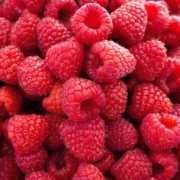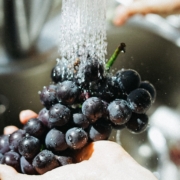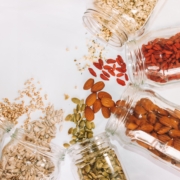Raspberries Top The New Food Preference List.
By Bill Adler, MPH, RS
Technical Food Safety Consultant
Okay, it isn’t precisely a pyramid. But it is a valuation of foods that are good for you. And raspberries received a 100 point score, which is the best you can get. Already, however, there is controversy over which foods made the ‘good for you’ list and which ones didn’t. For example, some cereals are ranked higher than eggs. This is causing no end to arguments. But, as a consumer, my wallet and taste predict what I’ll buy over what is better for me, from time to time.
Raspberries are a superfood. I should know because I grow them! This is not to say I am a nutritionist because I’m not. But it does say I like raspberry jam on my toasted English muffins. Haha, this makes me human, I guess.
Raspberries have one colossal drawback, and that’s the tiny crevices between the berry segments. As a result, they collect all sorts of nasties, including dirt, bird droppings, pollutants wafting over the gardens, etc. Back in 2000, there was a wedding-related outbreak due to the parasite Cyclospora cayetanensis. Eventually, the association was made to raspberries grown in Guatemala. I’ve seen pictures of the raspberry plants covered in bird droppings that were taken in Guatemala. It isn’t hard to believe some of those berries resulted in people getting sick because we like our berries fresh (uncooked) and served as an ingredient to salads, desserts, cereals, and fresh out of the garden.
Many of our favorite foods used to be seasonal. This is no longer the case. Looking at the Country of Origin label on fresh fruits and vegetables is surprising where our food comes from. Grapes, from January till early June, come from Central and South America. Other crops do, too.
Similarly, meats and fish are no longer just raised and processed by American producers. Sardines are caught and processed in the Philippines and Vietnam. Beef and farm-raised venison come from Australia and New Zealand. Fish and seafood might come from Canada and Belize. The American marketplace is a massive resource for producers around the world.
But, as far as fruits and vegetables are concerned, source identification doesn’t mean it is clean or safe. As consumers, it is our responsibility to ensure our safety as best we can. WASHING produce is a step in the right direction. Washing it in something beyond just water dissolves the dirt and removes organisms tucked in those nooks and crannies: places water alone may not do much. Our goal here at Life’s Pure Balance is to provide you with the means to make produce safer. By washing with the concentrated Fruit and Veggie Wash, you’ll be taking off contaminants on the outside, giving the produce a much better taste. So, Wash, rinse, and eat, knowing you did your best to make your table fare as clean as it can get.
Bill Adler is an expert in food safety, food-borne illnesses, and the foodservice inspection industry. He has conducted training for the Center for Disease Control and Prevention (CDC), teaching local, state, and federal disease investigators as well as working with laboratory specialists and epidemiologists. In addition, Bill has worked extensively with the Minnesota Department of Health (MDH) to perform food service inspections and train local and state public health employees.



